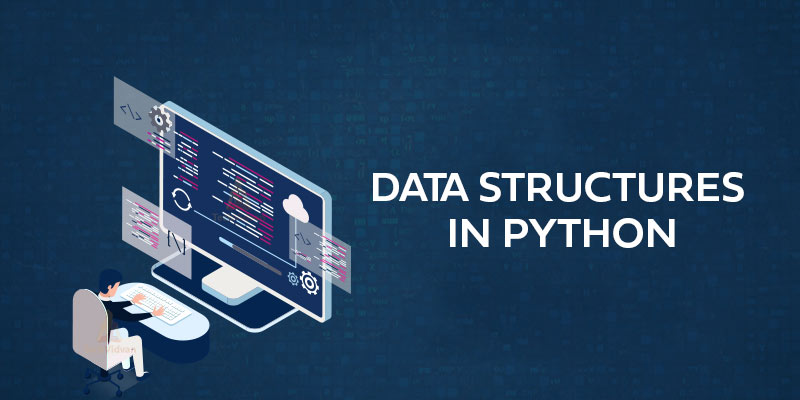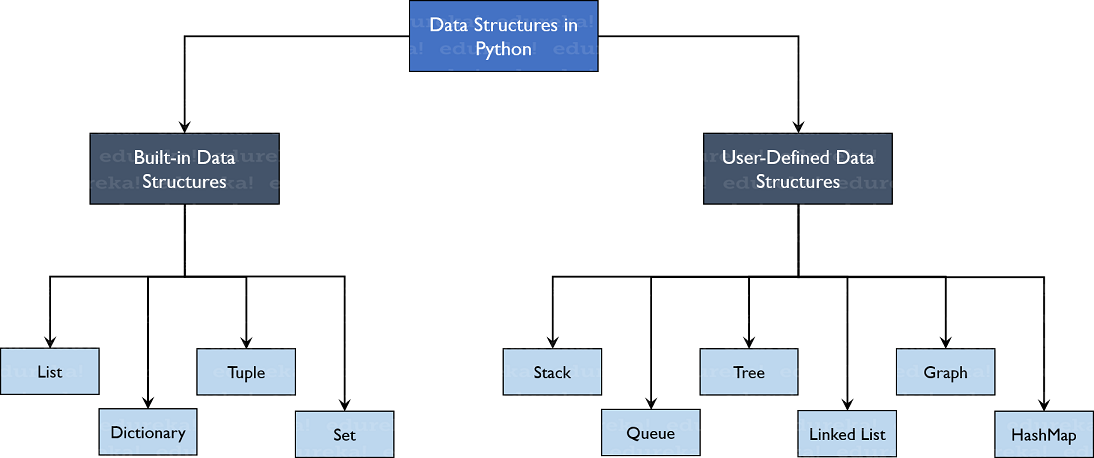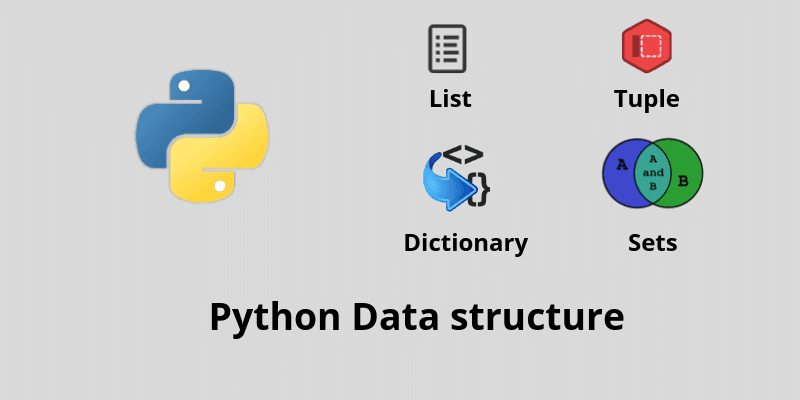This article was published as a part of the Data Science Blogathon
Python Programming Language has been used worldwide for different fields such as making websites, Software Engineering, Artificial Intelligence, Data Science, and much more. But to make all of these things possible, data plays a very important role which means that this data should be stored efficiently and access to it must be timely. So, to achieve this, we use something called Data Structures. So, In this article, we will go through the topics in Data Structures in Python.
 Image Source: Link
Image Source: Link
The topics which we are going to cover in this detailed article are as follows:
So, Let’s Get Started,
To enable easier access and efficient modifications, the utmost thing is to Organizing, managing, and storing data. And Data Structures allows us to organize the data in such a way that enables us to store collections of data, relate them and perform operations on them accordingly.
So, with the help of Data Structures, we can organize our data in such a way that it can be retrieved quickly. But one Data Structure is not sufficient to handle all the use case scenarios. That is why we have multiple data structures which can be used for various use cases.
Consider the following scenario, where you want to search for a particular document in file explorer with over thousands of documents stored. One way to do that is by going one by one in a linear way and find the required document, but this is a time-consuming process.
Another way is to jump directly go to that place where it is stored or where the related documents are present.
YES, your Operating System (OS) does this, using Indexing and hashtables which is a type of data structure. This reduces the time required to search even if there are lots of files present. This is why Data Structures are important.
In Python, we have implicit support for Data Structures that enable you to store and access data. In this, the data structures involved are as follows:
It’s not all but Python also allows its users to create their own Data Structures enabling them to have full control over their functionality. The most prominent Data Structures are
All these data structures mentioned above are also available to you in other programming languages such as C, Java, C++, etc. In this article, we have restricted our discussion only up to Built-In Data Structures in Python.

All about Different types of Data Structures present in Python
Image Source: Link
As the name suggests, the Data Structures that come under this category are built-in with Python which makes programming easier and helps programmers and Data Scientists to use them so that they can obtain the solutions much faster. The built-in data structures in Python are as follows:

Image Source: Link
Lists are the basic data structures and are used to store data of different data types in a sequential manner. During list formation, the Interpreter assigned the addresses to every element of the list called an Index. The index value in the list starts from 0 and goes on until the last element, this index is called the positive index. In Lists, we have also negative indexing which starts from -1 that enables us to access elements from the last to the first. Let us now understand lists and their functionalities in a better way with the help of the following examples.
To create a list, we can use the square brackets and add elements to it accordingly. If we do not pass any elements inside the square brackets, then we get an empty list as the output.
Accessing the elements of a list is the same as that of accessing the characters of Strings in Python. We have to pass the index values and can obtain the values as needed.
To know more about the string functions in Python, you can refer to my article link.
my_list = ['Analytics Vidhya', 2, 78.453, 'c']
# Accessing the elements one by one using a for loop
for element in my_list:
print(element)
# Access all the elements of a list
print("All elements:", my_list)
# Accessing the index 3 element from the list
print("Index 3 element:", my_list[3])
# Accessing the first two elements of the list
print("First Two elements:", my_list[0:2])
# Accessing the elements in reverse order
print("All elements in reverse order:", my_list[::-1])
Output:
Analytics Vidhya 2 78.453 c All elements: ['Analytics Vidhya', 2, 78.453, 'c'] Index 3 element: c First Two elements: ['Analytics Vidhya', 2] All elements in reverse order: ['c', 78.453, 2, 'Analytics Vidhya']
To add the elements to the list, we can use the append(), and extend() functions.
my_list = ['Analytics Vidhya', 2, 78.453, 'c'] # Adding a another list as a single element my_list.append(['Data Analyst', 'Data Scientist']) print(my_list) # Adding the another list elements as different elements my_list.extend(['Data Analyst', 'Data Scientist']) print(my_list)
Output:
['Analytics Vidhya', 2, 78.453, 'c', ['Data Analyst', 'Data Scientist']] ['Analytics Vidhya', 2, 78.453, 'c', ['Data Analyst', 'Data Scientist'], 'Data Analyst', 'Data Scientist']
To add the new elements at a specific index, we can use the insert() function that adds the element passed to the index value and increases the size of the list too.
my_list = ['Analytics Vidhya', 2, 78.453, 'c'] # Adding a new list at the second position my_list.insert(2, ['Data Analyst', 'Data Scientist']) print(my_list)
Output:
['Analytics Vidhya', 2, ['Data Analyst', 'Data Scientist'], 78.453, 'c']
To delete the elements at a specific index, we can use the del keyword which is built-in into Python but this does not return anything to us.
my_list = ['Analytics Vidhya', 2, 78.453, 'c'] # Remove the third element from the list del my_list[2] print(my_list)
Output:
['Analytics Vidhya', 2, 'c']
If we also want the element back after removing it from the list, we have to use the pop() function which takes the index value as its arguments.
Output:
['Analytics Vidhya', 2, 'c'] popped_element: 78.453
To remove an element by its value, we can use the remove() function.
my_list = ['Analytics Vidhya', 2, 78.453, 'c']
# Remove the 'c' element from the list
my_list.remove('c')
print(my_list)
Output:
['Analytics Vidhya', 2, 78.453]
To remove all the elements of a list, we can use the clear() function, which gives us an empty list after apply on a particular list.
For Example –
my_list = ['Analytics Vidhya', 2, 78.453, 'c'] # Remove all the elements from the list and make it empty my_list.clear() print(my_list)
Output:
[]
To sort the list, we use the sort() function. But while sorting you have to confirm that the data types of all the elements are the same since we cannot compare two different data types but you can use a mix of float and int data types while sorting a list.
my_list = [23,65,76.87,0,23.87] # Sort all the elements of a list in ascending order my_list.sort() print(my_list)
Output:
[0, 23, 23.87, 65, 76.87]
Tuples are somehow the same as that of lists but with the exception that the data once entered into the tuple cannot be changed no matter what i.e, Immutable. The only exception is when we have the data inside the tuple which is mutable (i.e, have a list, etc), only then we can change the tuple data. Let us now understand tuples and their functionalities in a better way with the help of the following examples.
We can create a tuple using parenthesis or using the tuple() function.
# Creating an empty tuple
empty_tuple = ()
print(empty_tuple)
print(type(empty_tuple))
# Creating a tuple with some data elements
my_tuple =('Data Scientist', 'Data Analyst', 'ML Engineer', 5)
print(my_tuple)
Output:
()
('Data Scientist', 'Data Analyst', 'ML Engineer', 5)
Accessing the elements of a tuple is the same as it is for accessing elements in lists.
my_tuple =(1, 56.87, 'Data Scientist', 'Data Analyst', 'ML Engineer', 'c')
# Accessing all the elements of a tuple
for element in my_tuple:
print(element)
# Accessing the first element of a tuple
print("First element:", my_tuple[0])
# Accessing the last element of a tuple
print("Last element:", my_tuple[-1])
# Accessing the first three elements of a tuple
print("First three elements:", my_tuple[0:3])
# Accessing the characters of a string in a tuple
print(my_tuple[3][5])
Output:
1 56.87 Data Scientist Data Analyst ML Engineer c First element: 1 Last element: c First three elements: (1, 56.87, 'Data Scientist') A
To find the index of a particular element in a tuple, we can use the index() function which takes the value of the element as an input for which we have to find the index. If we give an element that is not present in the tuple to index() function, then it gives the ValueError.
my_tuple =('Data Scientist', 'Data Analyst', 'ML Engineer', '5', 78.64)
print(my_tuple)
print(my_tuple.index('5'))
Output:
('Data Scientist', 'Data Analyst', 'ML Engineer', '5', 78.64)
3
To find how many times a particular element is present in the tuple, we can use the count() function which takes the value of the element as an input for which we have to find the frequency. If we give an element that is not present in the tuple to count() function, then it doesn’t give the error but gives the count of that element to zero.
my_tuple =(5, 'Data Scientist', 'Data Analyst', 'ML Engineer', '5', 78.64, 5) print(my_tuple) print(my_tuple.count(5))
Output:
(5, 'Data Scientist', 'Data Analyst', 'ML Engineer', '5', 78.64, 5) 2
To append the values in an existing tuple, we can use the ‘+’ operator, taking another tuple to be appended to it.
my_tuple =(5, 'Data Scientist', 'Data Analyst', 'ML Engineer', '5', 78.64, 5)
# Adding a single element to a tuple
my_tuple = my_tuple + ('Analytics Vidhya',)
print(my_tuple)
# Adding more than one elements to a tuple
my_tuple = my_tuple + ('Analytics Vidhya','Data Mastermind')
my_tuple
Output:
(5, 'Data Scientist', 'Data Analyst', 'ML Engineer', '5', 78.64, 5, 'Analytics Vidhya') (5, 'Data Scientist', 'Data Analyst', 'ML Engineer', '5', 78.64, 5, 'Analytics Vidhya', 'Analytics Vidhya', 'Data Mastermind')
Dictionaries are used to store the data in the form of key-value pairs.
To understand dictionary data structure you can think of a phone directory where we have hundreds and thousands of names of different persons and their corresponding phone numbers have been added. Now here are the constant values (i.e, Name) and the Phone Numbers which we referred to as the keys. And the various names and phone numbers are the values that have been fed to the keys. If we want to access the values of the keys, then we will obtain all the names and phone numbers.
So that is exactly what a key-value pair is. And in Python, this structure is stored using Dictionaries. Let us now understand dictionaries and their functionalities in a better way with the help of the following examples.
Dictionaries can be created using the flower braces or using the dict() function. We need to add the key-value pairs whenever we work with dictionaries.
# Creating an empty Dictionary
empty_dict = {}
print(empty_dict)
# Creating a Dictionary with some data elements
my_dict = {1: 'Analytics Vidhya', 2: 'Data Scientist', 3: 'Data Engineer'}
print(my_dict)
Output:
{}
{1: 'Analytics Vidhya', 2: 'Data Scientist', 3: 'Data Engineer'}
We can access the elements of a dictionary using the keys only. We can use either the get() function or just pass the key values and we will be retrieving the values.
my_dict = {1: 'Analytics Vidhya', 2: 'Data Scientist', 3: 'Data Engineer'}
# Get the value corresponding to key 3
Output:
Data Engineer 'Data Engineer'
To change the values of the dictionary, we can take the help of the keys. So, we have to firstly access the key and then change the value accordingly. To add values, we simply just add another key-value pair (See the example shown below).
my_dict = {'First': 'Analytics', 'Second': 'Machine Learning', 'Third': 'Data Science'}
print(my_dict)
# Changing the element
my_dict['Second'] = 'Deep Learning'
print(my_dict)
# Adding key-value pair
my_dict['Third'] = 'Data Mastermind'
print(my_dict)
Output:
{'First': 'Analytics', 'Second': 'Machine Learning', 'Third': 'Data Science'}
{'First': 'Analytics', 'Second': 'Deep Learning', 'Third': 'Data Science'}
{'First': 'Analytics', 'Second': 'Deep Learning', 'Third': 'Data Mastermind'}
To find the set of elements in a dictionary, we can use the items() function, which gives all the key-value pairs of a dictionary.
my_dict = {1: 'Analytics Vidhya', 2: 'Data Scientist', 3: 'Data Engineer'}
print(my_dict.items())
Output:
dict_items([(1, 'Analytics Vidhya'), (2, 'Data Scientist'), (3, 'Data Engineer')])
To find all the keys present in a dictionary, we can use the keys() function, which gives all the keys of a dictionary.
my_dict = {1: 'Analytics Vidhya', 2: 'Data Scientist', 3: 'Data Engineer'}
print(my_dict.keys())
Output:
dict_keys([1, 2, 3])
To find all the values present in a dictionary, we can use the values() function, which gives all the values of a dictionary.
my_dict = {1: 'Analytics Vidhya', 2: 'Data Scientist', 3: 'Data Engineer'}
print(my_dict.values())
Output:
dict_values(['Analytics Vidhya', 'Data Scientist', 'Data Engineer'])
Deleting Values: To delete the values, we can use the pop() function which returns the value that has been deleted.
Deleting Key-Value pair: To retrieve the key-value pair, we can use the popitem() function which returns a tuple key and value.
Deleting the Entire Dictionary: To clear the entire dictionary, we can use the clear() function.
my_dict = {'First': 'Analytics', 'Second': 'Machine Learning', 'Third': 'Data Science'}
# Pop the specified element
a = my_dict.pop('Third')
print('Value:', a)
print('Dictionary:', my_dict)
# Pop the complete key-value pair
b = my_dict.popitem()
print('Key, value pair:', b)
print('Dictionary', my_dict)
# Make the dictionary Empty
my_dict.clear()
print('Empty Dictionary', my_dict)
Output:
Value: Data Science
Dictionary: {'First': 'Analytics', 'Second': 'Machine Learning'}
Key, value pair: ('Second', 'Machine Learning')
Dictionary {'First': 'Analytics'}
Empty Dictionary {}
To know all about the operations and functionalities involved in Python Sets, you can refer to the following article link, which I published a couple of days back in Analytics Vidhya. I have included a detailed discussion of Python Sets in this article. So, please refer to this article completely and learn all the data structures in Python and accelerate your programming career.
An Intuitive and Easy Guide to Python Sets as a Data Structure
You can also check my previous blog posts.
Previous Data Science Blog posts.
Here is my Linkedin profile in case you want to connect with me. I’ll be happy to be connected with you.
For any queries, you can mail me on Gmail.
Thanks for reading!
I hope that you have enjoyed the article. If you like it, share it with your friends also. Something not mentioned or want to share your thoughts? Feel free to comment below And I’ll get back to you. 😉
The media shown in this article are not owned by Analytics Vidhya and are used at the Author’s discretion.
Lorem ipsum dolor sit amet, consectetur adipiscing elit,